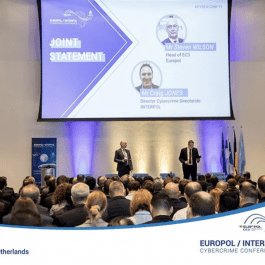- Home >
- Services >
- Access to Knowledge >
- Trend Monitor >
- Source of threat >
- Trend snippet: Experts from law enforcement, the private sector and academia are sharing knowledge on cybercrime
Trends in Security Information
The HSD Trendmonitor is designed to provide access to relevant content on various subjects in the safety and security domain, to identify relevant developments and to connect knowledge and organisations. The safety and security domain encompasses a vast number of subjects. Four relevant taxonomies (type of threat or opportunity, victim, source of threat and domain of application) have been constructed in order to visualize all of these subjects. The taxonomies and related category descriptions have been carefully composed according to other taxonomies, European and international standards and our own expertise.
In order to identify safety and security related trends, relevant reports and HSD news articles are continuously scanned, analysed and classified by hand according to the four taxonomies. This results in a wide array of observations, which we call ‘Trend Snippets’. Multiple Trend Snippets combined can provide insights into safety and security trends. The size of the circles shows the relative weight of the topic, the filters can be used to further select the most relevant content for you. If you have an addition, question or remark, drop us a line at info@securitydelta.nl.
visible on larger screens only
Please expand your browser window.
Or enjoy this interactive application on your desktop or laptop.
Experts from law enforcement, the private sector and academia are sharing knowledge on cybercrime
Two conclusions of the conference:
Business Email Compromise (BEC): while BEC is not new, it is evolving, causing increasing economic damage. BEC exploits the way corporations do business, taking advantage of segregated corporate structures, and internal gaps in payment verification processes.
Dark web: as the dark web evolves, it has become a threat in its own right, and not only as a medium for the sale of illicit commodities such as drugs, firearms or compromised data. The impact of law enforcement action in this arena is palpable as the environment remains in a state of flux.
More than 400 experts from law enforcement, the private sector, and academia have gathered last week at Europol’s headquarters in The Hague for one of the world’s biggest platforms of exchange on cybercrime. Under the theme of ‘Law enforcement in a connected future’, the 7th Europol-INTERPOL Cybercrime Conference looked at ways how to effectively combine the expertise, resources and insights of law enforcement, the private sector and academia to make the internet a more secure environment, especially in a society, which is becoming increasingly dependent on digital capabilities.
Conclusions emphasised a need for an even closer cooperation in the areas of:
- Business Email Compromise (BEC): while BEC is not new, it is evolving, causing increasing economic damage. BEC exploits the way corporations do business, taking advantage of segregated corporate structures, and internal gaps in payment verification processes.
- Dark web: as the dark web evolves, it has become a threat in its own right, and not only as a medium for the sale of illicit commodities such as drugs, firearms or compromised data. The impact of law enforcement action in this arena is palpable as the environment remains in a state of flux.
- Research & Development: Technology develops at an ever increasing pace, creating new challenges and opportunities for law enforcement. Adding to this the data volume challenge, legal challenges and a constantly expanding threat surface, there is a need for research and development to develop solutions addressing the needs of law enforcement in an efficient and agile way.
- Innovation: The incorporation of innovation, as part of an effective crime response, is not exclusively a private sector affair. Europol and INTERPOL already cooperate with industry partners and academia to identify challenges and opportunities for law enforcement arising from new and emerging technologies, such as 5G.




